HOW TO USE PSYCHOLOGY TO MAKE YOUR NEW YEAR’S RESOLUTION STICK!
How To Use Psychology To Make Your New Year’s Resolutions Stick!
New Years Resolutions – By Dr Pat Partington
(Click on the Reference Numbers in Blue for More Info)
Did you make a new year’s resolution this year? Maybe it’s to lose weight, get fit, look after your mental health, read more books or be more sociable? Well, I’ve got good news and bad news for you and as everyone tends to want the bad news first – there’s probably a name for it – that’s the way we’ll go.
Most people who make new year’s resolutions fail. Yes, it’s always best to tell it like it is when it comes to bad news, so there you have it. Although the research on this is thin, there are studies (1) that go so far as to say that a third of resolutions will fail by the middle of January and that each year, two-thirds of gym memberships go unused. But the good news is that there are things you can do that psychological studies have shown will make your resolutions stick. In fact, if you have made a resolution you’ve already given your motivation a massive kick start, here’s why.
In psychology, there is something called the “fresh start effect” (2), and it can be a powerful motivator. It proposes that landmarks in time (for example tomorrow, Monday, next month, after my birthday, in the new year) are psychological reset points that serve as a starting line for new challenges. For example, it’s difficult to be enthusiastic about starting a diet on a Friday because there are going to be too many temptations over the weekend, but Monday offers a fresh start. I think it’s safe to say we’ve all made use of this natural reset mechanism of the brain.
Things are going to be different for you after your birthday, you’ll get more disciplined and organised, you’ll prioritise your career before it’s too late, you’ll spend quality time with your family while they are still young, yes that’s what you are going to do. We view the world ahead of these reset points enthusiastically and in full colour, while anything behind them can seem like a hazy world of grey, soon passed and easily forgotten. The fresh start effect gives you psychological distance from your past failures as if that was the ‘old you’ but the ‘new you’ is going to be different. Yes, the fresh start is very aspirational and motivating.
Hang on though, we’ve already seen how the biggest fresh start of all, the new year, is notorious for its failure in long-term behaviour change, so what’s happening? Well, and maybe I should have mentioned this earlier, the fresh start effect is something of a double-edged sword. Yes, it’s a great motivational confidence-booster but all too often this enthusiasm leads us to make promises to ourselves that we simply aren’t able to deliver. More importantly, it leaves us completely unprepared for the obstacles that will do their best to trip us up along the way.
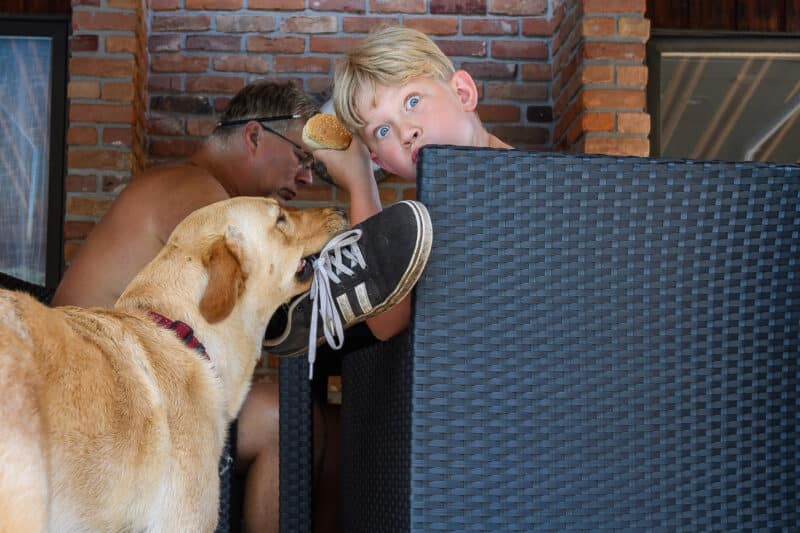
Picture the scene
It’s 8 o’clock in the evening during the third week of January. Julie is sitting at home on her sofa. She wants to lose weight and she had planned to go out for a power walk tonight with her friend, Tracy, but Tracy had called with bad news. Her dog had eaten her walking shoe. As Julie took the call and sympathised with her barefoot friend: “You poor thing, I can’t believe it”, she became aware of a sensation in her stomach. If sensations could talk this one was saying “Yessssssss!”
Back on the sofa, Julie remembers her new year’s resolution with Tracy, “to lose weight and be happy”. That seems like a long time ago now, and she starts thinking: “I don’t really want to go out on my own. It’s very dark out and they’ve forecast rain. I didn’t know a dog could eat a shoe”. Julie isn’t going out tonight. “I’ll do extra tomorrow,” she says to herself, doing her best to ignore the quiet voice in her mind that’s saying: “tomorrow’s Friday, nobody gets back into exercise on a Friday”.
In another house not far away a man says to his wife: “Did you phone Julie?” “Yes” replies Tracy, smiling at their sleeping dog. Oh, how they laugh.
Julie’s settled for the evening. She starts thinking about the one thing that people on diets must never think about. Food. Her mind drifts back two hours in time to her dinner and she is reminded of how good a salad can taste in January. But not her salad. “I only had a salad because I thought I was walking tonight,” she thinks firmly. Oh dear, here we go. “My head’s not right at the moment,” she tells herself and very quickly visions of Jaffa cakes dance in her mind. She moves slowly but surely to the kitchen.
“I’ll just eat the one,” she says but three fall accidentally into her hungry hand. Shrugging her shoulders, and holding her booty lightly to avoid melting chocolate, she returns to the sofa. After eating quickly, but wishing she had eaten slowly, her mind is now on the television. But not for long. “I’m going to have another Jaffa cake”, Julie is determined to have just the one.
Fast-forward half an hour. A box of Jaffa cakes has disappeared. Julie, chocolate around mouth and crumbs on lap, is very disappointed with herself. The damage, however, has been done so Julie is now thinking about a glass of wine and maybe a few crisps. Fast forward again to the end of the evening and Julie is asleep in front of the TV, an empty bottle of wine and a half-eaten luxury bag of crisps sit apologetically alongside her. Damn that dog!
Julie wakes up in the morning feeling slightly guilty. She remembers that she is going to do an extra-long walk tonight after work. But then she remembers she’s going out for a meal on Saturday. “No,” she thinks, “I’ll get the weekend out of the way and start again on Monday”. Let’s leave Julie there for a moment.
These seemingly minor interruptions to Julie’s weight loss ambitions need only occur a few times for her self-belief and motivation to take an irreversible nosedive. However, in the short-term tomorrow is another day, as they say, a fresh start that can make everything look more achievable. Monday is an even bigger fresh start, a new week that, from here on a Friday morning, offers the chance to wipe the weekend slate completely clean.
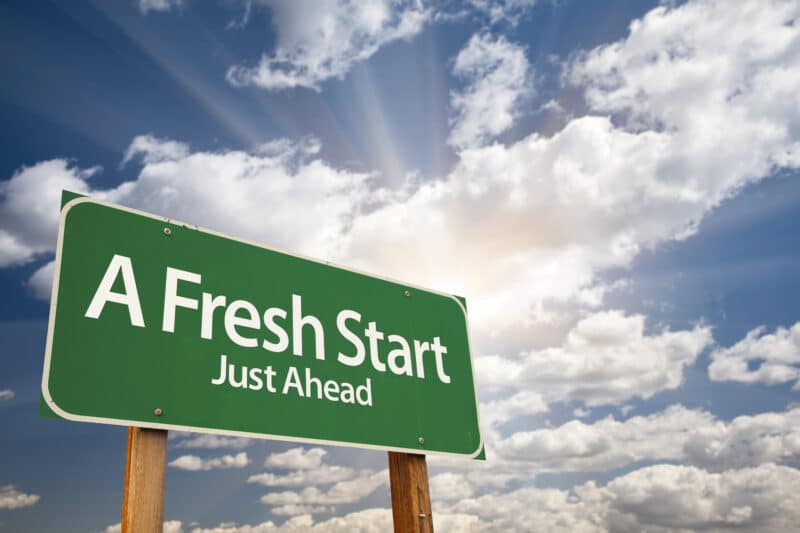
WOOP – Wish, Outcome, Obstacle and Plan
So how do we get the most out of the motivation that comes with the fresh start, while also eliminating the overconfidence and accompanying ease of procrastination?
The renowned professor of psychology Gabriele Oettingen has spent the past two decades researching the ways that people think about the future and how these thoughts impact our motivation and behaviour. She began by designing experiments whereby people would dream about their future successes in a ‘believe it and achieve it’ style but found that solely dreaming about future success would inevitably lead to failure. Oettingen found (3) that, while mental imagery remains a vital component of any behaviour change effort, it is much more effective when we give our dreams a reality check by contrasting the outcome with the obstacles we’ll inevitably face along the way.
If you only focus on the final success – perhaps you with a perfect body on the beach alongside all the other beautiful people – your subconscious mind will assume that victory is a given and you won’t be prepared for the hard work needed to achieve this outcome. Far better to also visualise yourself overcoming the difficulties you’ll encounter on the way to your ultimate dream, which Oettingen calls mental contrasting.
To put mental contrasting into practice, you simply compare two things in succession, firstly your wish followed quickly by the reality of how challenging it might be to achieve it. Experiencing the contrast between where you want to be and where you currently are, will bring about a psychological necessity of action. This quote from Gabriele Oettingen (4) nicely sums up the process:
Think of a wish. For a few minutes, imagine the wish coming true, letting your mind wander and drift where it will. Then shift gears. Spend a few more minutes, imagining the obstacles that stand in the way of realising your wish.
Oettingen combined the steps of this process into the acronym WOOP, which represents Wish, Outcome, Obstacle and Plan.
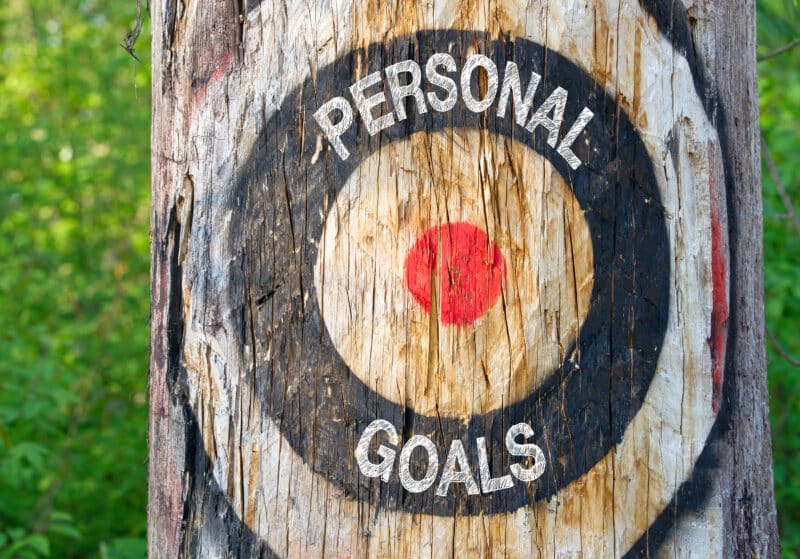
How To Use Psychology To Make Your New Year’s Resolutions Stick! – Wish
Think of one important and attainable goal. Important because it has value to you and attainable because, well it might seem obvious, but the more attainable your goal the more likely you are to succeed. This is important because success breeds success, given that once you have that feeling of achievement your brain will produce a little of the reward chemical called dopamine, which makes sure that your motivation continues (5).
So for example, you might want to lose two stone in weight and, while this is certainly achievable, your efforts at weight loss are going to be much more attainable if, for example, you aim to lose four pounds in the first three weeks of January. To make your wish come true, then, take small steps toward your ultimate goal.
This approach is nothing new, considering that we have known about SMART goal-setting for a long time now (6). SMART, another acronym, stands for specific, measurable, achievable, relevant and time-bound. This, of course, is just the starting point for your resolution, and now we need to drill a little deeper into the process.

How To Use Psychology To Make Your New Year’s Resolutions Stick! – Outcome
It is important to frame your outcomes as positively as possible, given we know that “approach goals” are more effective than “avoidance goals” (7). For more information on this see our previous article, Is our motivation making us fat and what can we do about it? which explains why the carrot is more effective than the stick. So for weight loss it is better to be motivated toward the good feelings of being a healthy weight rather than away from the bad feelings of being overweight.
Along the same lines, instead of stopping things (away from), you should start doing things (toward). Rather than focus on the foods you are going to cut out, concentrate on the healthy foods you will enjoy introducing into your diet. What’s more, your outcome must be something that you want for yourself, rather than what someone else wants for you, because this causes an internal conflict that can lead to self-sabotage. So lose weight for yourself, nobody else.
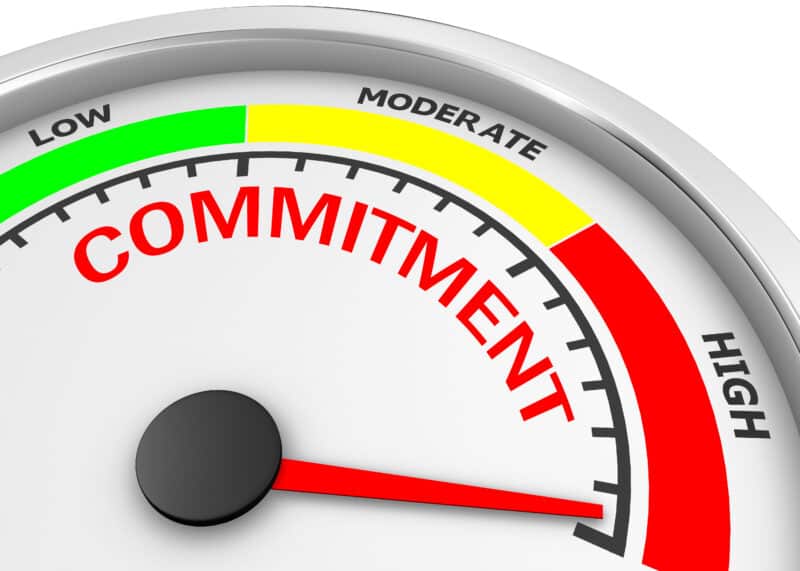
How To Use Psychology To Make Your New Year’s Resolutions Stick! – Obstacles
Mental contrasting is a reality-bound and solution-focused practice whereby you contrast your wish against an obstacle to achievement. This results in strong goal commitment, so in this step you must reflect on the possible difficulties you might face while striving to make your wish come true. More specifically, you are encouraged to think of the internal obstacles that are holding you back or preventing you from moving forward, such as self-defeating thoughts, feelings, behaviours, or mindsets.
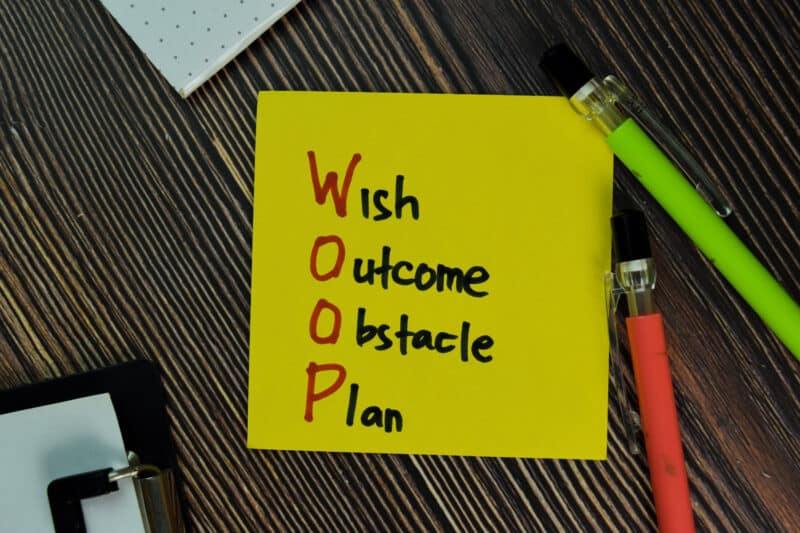
How To Use Psychology To Make Your New Year’s Resolutions Stick! – Plan
As the motivational speaker and author Zig Ziglar has said, “people do not wander around and then find themselves on Mount Everest”. No, whether it’s Mount Everest or losing weight for your holiday, you’re going to need a plan. However, it doesn’t need to be overcomplicated, it just needs to be something that you can put in place when you come up against the obstacle.
While researchers (8) have called this an “implementation intention”, Oettingen frames it as an “if-then” plan. “If” the obstacle appears “then” I will perform my planned action to overcome it. Either way, research has shown it to be a powerful self-regulatory tool for successful behaviour change.
When completing the WOOP sheet we should focus on just one of the obstacles we might encounter when achieving our goal. If I encounter obstacle X, then I will respond with action Y. We are enacting a pre-planned script in the face of inevitable challenges.
The WOOP sheet looks like this:
What is my wish / What do I want to achieve?
What would be the best outcome from my wish?
What is a likely obstacle in my way?
What is my plan to overcome this obstacle? If………………… Then…………………
- Now, close your eyes and imagine the best things that you can associate with fulfilling your wish. Take your time to imagine as vividly as possible the entire experience. What emotions are you aware of, how do you feel in your body? Associate into those emotions so you feel them now. Think about why you value this so highly and really get into the emotion.
- Open your eyes and enjoy the feeling of knowing where you are going with your resolution.
- Now, as with the outcome, close your eyes and take as long as you need to reflect fully on your impending challenge, imagining how it will play out in reality. When you are ready, visualise putting your plan into action. As you engage in the imagery you are utilising mental contrasting, which so much good research evidence tells us will make your behaviour change efforts much more successful.
- Enjoy the feeling of confidence you have from knowing you can overcome this obstacle when it comes your way.
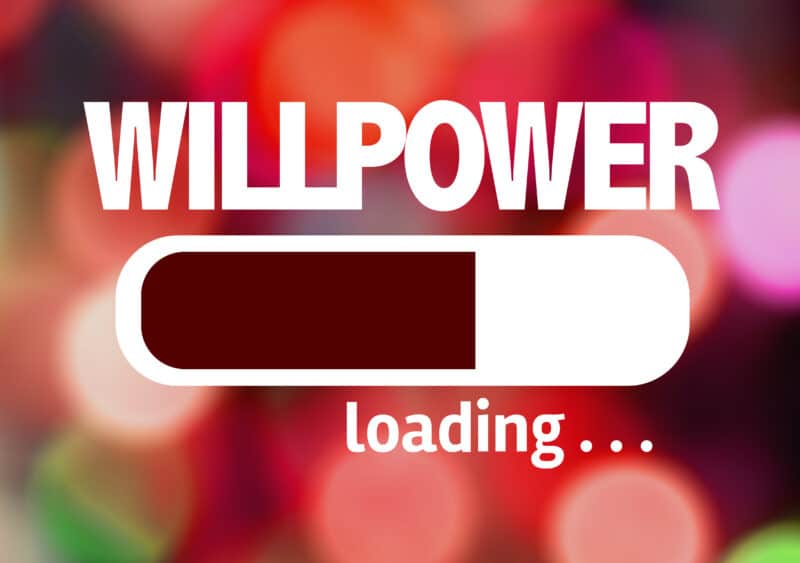
Hey Julie, where did it all go wrong?
Julie’s experience might seem like a trivial scenario that simply demonstrates her lack of willpower, but the fact is that it’s very often the small things that scupper our plans. What’s more, when we are anticipating barriers to success it’s often these minor inconveniences that are overlooked in favour of the more obvious and major interferences, such as regularly having to work late or a friend’s unavoidable birthday party.
Julie had two big things in her favour, the fresh start effect and the social support of an exercise partner. Buddying up with a like-minded partner is an effective strategy for long-term adherence (9) but Julie fell at the first hurdle, which could have been different if she had done a WOOP!
This is what her WOOP should have looked like, given that she already knows how unreliable her friend can be:
What is my wish? What do I want to achieve?
I want to lose 4lbs of weight by 22nd January.
What would be the best outcomes from my wish?
I’ll be happy that I’ve achieved something. I’ll feel in control and that things are starting to change for me. I’ll feel motivated to keep it going.
What is a likely obstacle in my way?
My friend might cancel at the last minute.
What is my plan to overcome this obstacle?
If… Tracy cancels, Then… I’ll quickly remind myself of why I’m losing weight and I’ll listen to my self-hypnosis audio recording, which always gets me fired-up and motivated!
Once you have achieved your wish, use the WOOP process to set yourself another, which you can again bring to fruition with mental contrasting. Remember to keep it short term and achievable. If you were not successful in reaching the goal you set for yourself – perhaps because of an unexpected obstacle that came along – simply reset and re-WOOP.
In the field of neurolinguistic programming (NLP) the saying is that “there is no such thing as failure only feedback”. Those in the business of sport often say, “we never lose, we either win or we learn”. Short term goal-setting means there are many opportunities to learn, reset and go again, but by the same token success breeds success
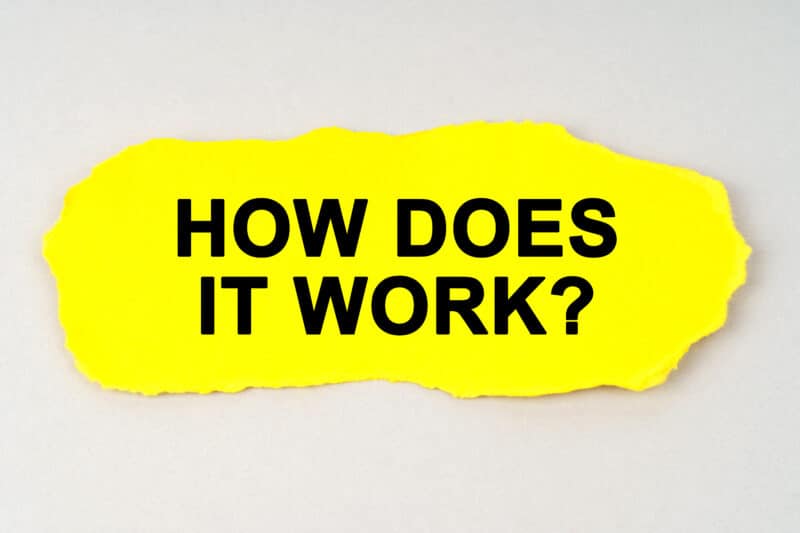
How does WOOP work?
Something that Oettingen or anyone who promotes this type of approach never tells us is exactly how the WOOP process works. What’s the mechanism of action that makes WOOP so effective? Well, I’m in the business of educational therapy, which tells us that therapy is more effective when we know how it works. There are two key points to the success of WOOP.
Firstly, the brain works by association, it’s a pattern-matcher that is always looking for previous responses to draw upon whenever you find yourself in any type of situation. This works for good and bad, so when you find yourself with a challenge that you previously failed to overcome, your brain will reenact that previous failure. Although you logically know what you should do, your brain needs a fast response (our survival has always depended on this) so it’s easier to use the existing ‘script’ in your brain (10). If you are trying to lose weight there’s a good chance that you have a few previous failures stored away in your brain.
Secondly, mental imagery and reality make use of the same cortical structures in the brain, so if you can imagine something well enough as far as your brain is concerned it has happened (11). Effectively, a memory trace is laid down in your brain and the more often you practice the deeper this memory becomes etched into your brain. In other words, the WOOP process installs a memory of overcoming an obstacle even before it has happened. So think of your brain as a search engine that is constantly Googling for responses to events and situations in which you find yourself. These responses are previous experiences held in your brain as memory traces. Regularly practising the WOOP process will ensure that your brain will more easily return, and enact, the successful script that is now stored away in your memory banks.

How To Use Psychology To Make Your New Year’s Resolutions Stick! – Conclusion
The fresh start effect can be a powerful motivator, but while it gives us the wish and the outcome, it offers no reality check. In fact, it deletes the reality, wiping clean the slate of previous failures and offering preemptive permission to party until the fresh start begins. However, everything changes when we add the reality check of an inevitable obstacle and a plan for overcoming that obstacle. The scientifically validated WOOP provides an easy to use, psychologically-informed process that more reliably turns your new year’s wish into reality.
Grounded in twenty years of research in the science of motivation, WOOP represents a unique notion: the obstacles most likely to stop our wishes from coming true can actually be used to help us realise them. WOOP has helped people increase their physical activity (12), stick to healthy diets (13), increase physical capacity with chronic pain (14), increase physical activity with depression (15) and even become more tolerant and socially responsible (16). Children and adolescents using WOOP improved school attendance (17) as well as effort and achievement in school (18).
So what’s the take-home message? Don’t be like Julie, be sure to give your New Year’s fresh start the WOOP treatment. Not just once but regularly throughout your behaviour change journey.
If you enjoyed this New Years Resolution article please check out the links below.
